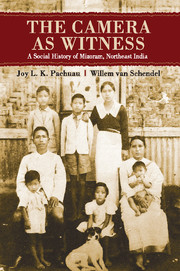Book contents
23 - Studio Modernity
from IV - Mizo Modernities
Published online by Cambridge University Press: 05 May 2015
Summary
Many photographs in our collection originate from photo studios. They are the work of professionals who made a living out of photography. In this chapter, we are interested in the ways in which these photographers composed their images by arranging their clients and props to convey impressions of sophistication and modernity. Professional photographers also recorded important events outside their studios, such as weddings, funerals and public ceremonies. In this chapter, we focus on the photographs created in the intimacy of the studio.
We have collected photographs produced by studios in Mizoram, Manipur, Chin State and the Chittagong Hill Tracts, as well as further afield. The studios we have been able to identify were located in Aizawl, Champhai, Lunglei, Saiha, Lawngtlai, Imphal, Churachandpur and Vanghmun (all: India); Tahan (Burma) and Rangamati (Bangladesh). Further afield were studios in Silchar, Shillong, Guwahati, Kolkata, Jabalpur, Allahabad and Pune (all: India); Chittagong and Sylhet (Bangladesh); Mandalay (Burma); Karachi (Pakistan); London, Aberystwyth and Liverpool (United Kingdom); Bogotá (Colombia) and Philadelphia and Delaware (United States). For several – especially wartime – studio photographs, the exact location is unknown.
The earliest studio photographs are not from Mizoram itself, simply because there were no photo studios in the area. People from Mizoram usually had their pictures taken in studios in Silchar, Sylhet and Shillong (all in Assam at that time), and in Kolkata. Young men serving in the armed forces sent back photographs from where they were stationed, for example in Allahabad (northern India), and in Chapters 5 and 9 we have seen that students and wartime soldiers sent studio portraits from as far afield as the United States, France and Iran.
In the earliest studio portraits, we see carefully arranged groups of men posing with props – such as small tables with pots of flowers, draped curtains and carpets – that were not part of their everyday lives. These accoutrements were standard equipment of photo studios all over British India and beyond; and they served to communicate civilized refinement (Figure 23.1).
- Type
- Chapter
- Information
- The Camera as WitnessA Social History of Mizoram, Northeast India, pp. 410 - 422Publisher: Cambridge University PressPrint publication year: 2015

